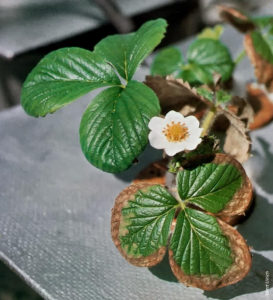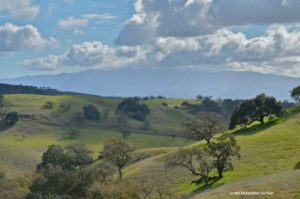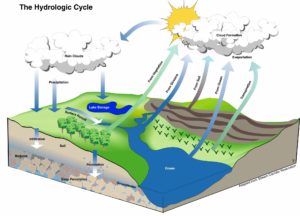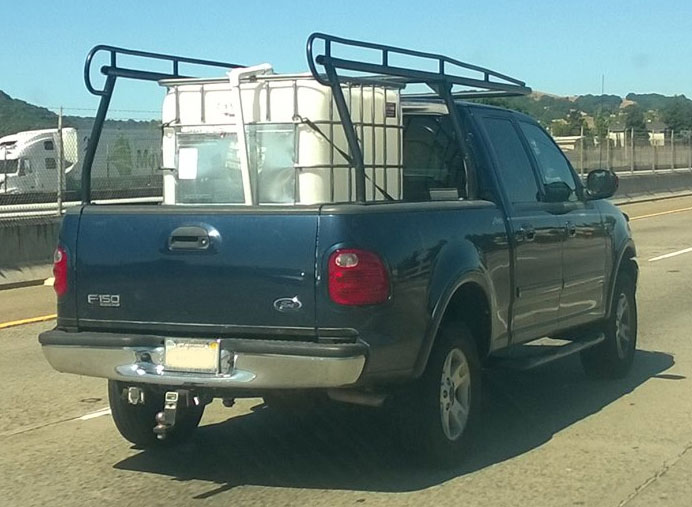As we’ve learned about the growth potential associated with recycled water, rainwater has its own magical attributes too.
“Despite all our accomplishments, we owe our existence to a six-inch layer of topsoil and the fact it rains.” – Unknown
A gift from the heavens and responsible for all life on the planet, what is so special about rainwater that you won’t find in drinking water or recycled water? Lets analyze the three.
For this exercise, we need to reference the hydrological cycle to re-affirm how rainwater is produced. Rain is formed by sea water evaporating into clouds, when the clouds become thick with moisture wind pushes them over land and magically water droplets form and fall back to the earth.
On the way down, this pristine water source will pick up nutrients in the air and carry them to the ground. Depending on the air quality where you live, this could be pollution or molecules for sustaining life (nitrogen/oxygen).
Better Living Through Chemistry
Unlike rainwater, tap water will contain some or all the extra “ingredients” that drinking water treatment facilities add to make the water safer for human consumption (federal, state and regional drinking water standards are followed per allowable limits). These chemicals include: chlorine (for disinfection), fluoride (helps prevent tooth decay), calcium, magnesium, potassium, and sodium (water softeners).

Salt build up can cause brown leaves.
Just because they’re good for humans doesn’t mean plants like it too.
Some plants generally don’t do well with these chemicals on them and could cause damage to leaves (browning leaves), or cause root rot.
Rainwater is a naturally “soft” water, as you’ve learned, it is missing the chemicals found in drinking water. It is also highly oxygenated (think of that long trip from cloud to ground) which helps bring oxygen to plant roots under the soil.
The pH of rainwater is relatively neutral, if not slightly acidic. Plants generally grow well in slightly acidic soil (pH between 5.5 and 6.5). Tap water is known to be slightly basic – levels have been seen as high as 8.5 due to an alkaline chemical added to protect metal pipes from corroding.
By comparison, recycled water has been proven make plants grow bigger than those already watered with drinking water. This blog did a study and found that to be true. You’ll need to ask your local recycled water provider what is in their water that could provide you with similar results.
Greenery
In California, it is rainwater that turns our golden hills green in the winter time. At many homes, where unsustainable water hungry lawns still cover vast expanses of landscapes, rainwater is the winter time gift that keeps lawns lush. Using excessive quantities of drinking water to reach the same effect in the summer time is a waste. If only homeowners with lawns were responsible to store their own rainwater for the summer watering season … The drought could be over! <wishful thinking>
Rainwater provides an amazing gift to nature. It is very evident in surrounding hills and open spaces where we haven’t seen new plant growth all year.
At home, take a look at the garden or your landscape. What do you notice? In many places, seeds that have fallen throughout the year have now sprung to life.
Any plant growing in an area where you don’t want it is considered a weed.
I’ve been digging in my front yard, turning over a couple of yards of soil and now it is is covered in little plants. Plants that I don’t want to grow there and thus they’re weeds to me. I haven’t watered them, mother nature did. Rainwater is the fountain of life as it brought life to these dormant seeds.
Live Forever
In order for us to become self-sustainable and live forever, we need to capture as much rainwater at home. Reduce run-off from our homes to the impervious surface that is the street gutter and put the water in holding tanks or let it absorb into the ground.

Lawn-to-Garden remodel, 2015
For example, two years ago I built a swale in my front yard, think of it like a reverse french drain – rainwater from the roof gutters flows down a perforated pipe and then drains into the ground. The soil and the plants around this swale grew like crazy.

Front yard, 2016.
As winter and spring rains subsided, I noticed my neighbors were turning their sprinklers back on again. I stuck my finger in the ground around the swale and it was soaking wet. It took nearly a month for the ground to dry out.
That month meant I didn’t need to provide excess irrigation, saving a months’ worth of water. Imagine if everyone directed rainwater to the ground instead of the street? We could conserve an extra months’ worth of water, saving millions of gallons of water.
How do you build a swale? I’ll show you in the coming articles. I’ve spent the summer readying a space, join me on this adventure. I’ve done all the work myself, canceling my gym membership in the process.





Very sweet blog about rainwater qualities. I wonder if you could explain this sentence, as I am not clear. “Just because they’re good for you and I doesn’t mean plants like it too.” No doubt you know that chloramine and fluoride are not good for humans and neither are they good for plants.
Chloramines are used as a disinfectant in drinking water. It has been in use since the 1930’s. (https://www.epa.gov/dwreginfo/chloramines-drinking-water) As long as the water treatment provider keeps chloramine levels in check, then you’re going to be ok.
As for Fluroride, the American Dental Association supports its inclusion as they have claimed it helps lessen tooth decay. (http://www.ada.org/en/public-programs/advocating-for-the-public/fluoride-and-fluoridation)
The best thing you can do to learn about what is in your drinking water, is to ask your local water provider about what chemicals they use to treat your water supply.
When it comes to plants, nature has proven they grow better on rain water instead of drinking water. 🙂
Chloramines were reupped in 90s I believe, after a long hiatus after WWII. Chloramines can have negative impacts on those with compromised immune systems, are deadly to aquatic life, and stay in drinking water longer than Chlorine. So rainwater is a much better source, as you point out.